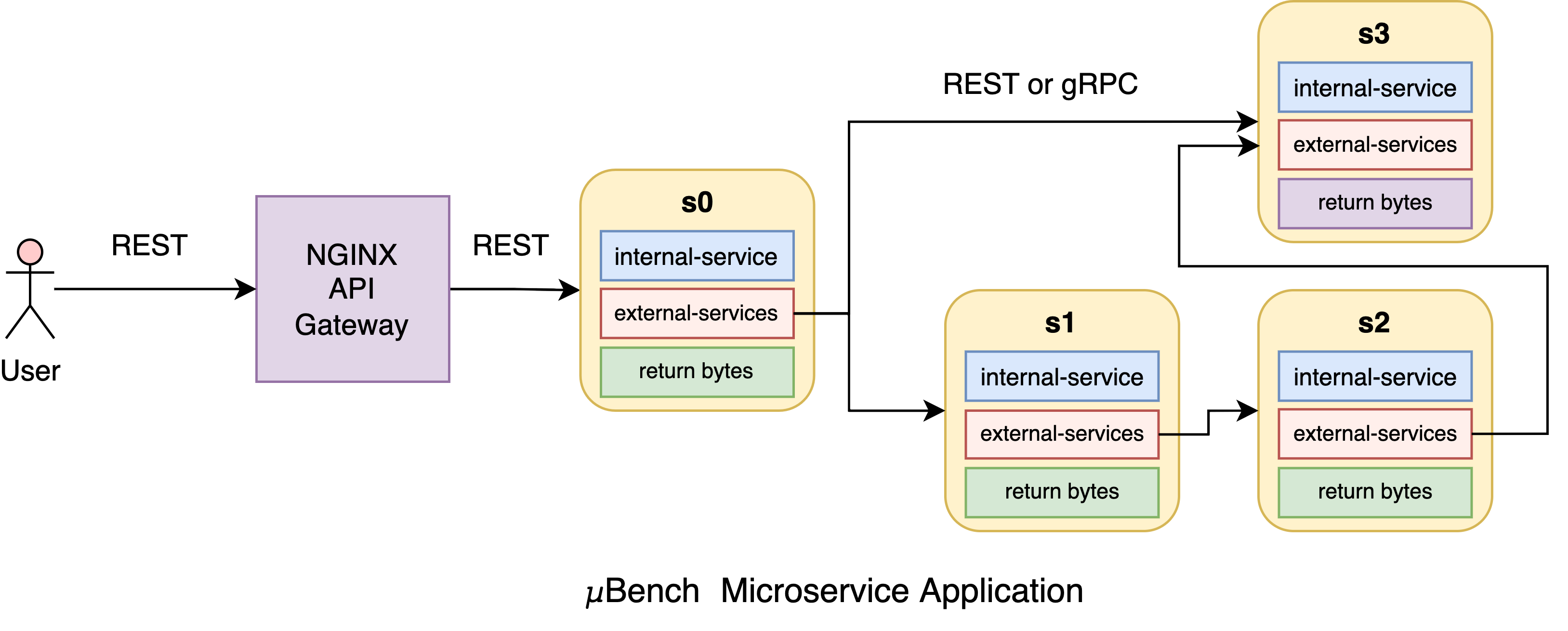µBench is a tool for benchmarking cloud/edge computing platforms that run microservice applications. The tool creates dummy microservice applications that can be customized by the user and run on Kubernetes.
µBench targets researchers and cloud platform developers who lack real microservice applications to benchmark their findings (e.g., new resource control mechanisms, AI-driven orchestration, etc.). Indeed, µBench can create these applications for them. At the same time, µBench can also be used for educational purposes to show the advantages and problems of microservice applications to students.
µBench allows users to control some properties of the microservice application it creates, such as:
- the dependency graph of the microservice application
- the behaviors of composing microservices using a portfolio of stress functions (e.g. for CPU, memory, I/O, network) or implementing new ones,
- the microservice-to-microservice API (HTTP or gRPC)
- the CPU and Memory resources assigned to microservices and their number of replicas
µBench provides a comprehensive monitoring framework consisting of Prometheus, Grafana, Istio, Kiali, and Jaeger through which to observe the performance of the produced benchmark applications.
A poster outlining the main features of µBench is available here
You can learn how to use µBench to create and monitor your application by reading the µBench manual.
For a complete install guide, head over to the manual. Instead, for a quick hands-on with µBench the following commands will deploy a microservice application composed of 10 services with a star topology service graph. Clients send requests to s0 and s0 sequentially calls all other services before sending the result to clients. Each service equally stresses the CPU.
We assume that on your host, you have Docker and access to a Kubernetes cluster with kubectl tool. If you need to configure a Kubernetes cluster (e.g., with Minikube) or for other configurations read the manual.
We will use the Docker µBench container that contains all the necessary software.
Run the µBench container
docker run -d --name mubench msvcbench/mubenchCopy the .kube/config file you use in your host to access the Kubernetes cluster in the container
kubectl config view --flatten > config
docker cp config mubench:/root/.kube/configIn case update the server: key of config file with the correct IP address of the master node of the cluster. Verify that the µBench container can access your cluster, e.g., by using the next command from your host
docker exec mubench kubectl get nodesEnter the µBench container with:
docker exec -it mubench bashNow your terminal should be in the µBench container from which you will run the next commands
╱╱╱╭━━╮╱╱╱╱╱╱╱╱╱╭╮
╱╱╱┃╭╮┃╱╱╱╱╱╱╱╱╱┃┃
╭╮╭┫╰╯╰┳━━┳━╮╭━━┫╰━╮
┃╰╯┃╭━╮┃┃━┫╭╮┫╭━┫╭╮┃
┃┃┃┃╰━╯┃┃━┫┃┃┃╰━┫┃┃┃
╰┻┻┻━━━┻━━┻╯╰┻━━┻╯╰╯
root@64ae03d1e5b8:~# Deploy the µBench demo app with
cd $HOME/muBench
python3 Deployers/K8sDeployer/RunK8sDeployer.py -c Configs/K8sParameters.jsonCheck the correct deployment of the application pods with
kubectl get pods You should see the following pods
root@64ae03d1e5b8:~/muBench# k get pods
NAME READY STATUS RESTARTS AGE
gw-nginx-5b66796c85-fpqvc 2/2 Running 0 11m
s0-7d7f8c875b-gk2pq 2/2 Running 0 11m
s1-8fcb67d75-pncwq 2/2 Running 0 11m
s2-558f544b94-kft64 2/2 Running 0 11m
s3-79485f9857-5j79h 2/2 Running 0 11m
s4-9b6f9f77b-dklvm 2/2 Running 0 11m
s5-6ccddd9b47-n5pz7 2/2 Running 0 11m
s6-7c87c79cd6-pt26s 2/2 Running 0 11m
s7-5fb7cbff7c-hkd6t 2/2 Running 0 11m
s8-5549949968-72q2z 2/2 Running 0 11m
s9-9576b784c-4npsj 2/2 Running 0 11mTest the correct execution of the application with
curl http://<MASTER_IP>:31113/s0where MASTER_IP is the IP address of the master node of the Kubernetes cluster.
If you receive back a sequence of random letters, it means that your first µBench app is running :-).
Read the manual to create and monitor your benchmark apps.
NOTE:: edit Configs/K8sParameters.json if your Kubernetes dns-resolver service is different from
kube-dns. For instance, for some clusters it is namedcoredns. Otherwise, nginx pod gets error status.
The description of µBench and some use cases have been published in IEEE Transactions on Parallel and Distributed Systems. If you use the µBench please cite the following publication:
A. Detti, L. Funari and L. Petrucci, "μBench: An Open-Source Factory of Benchmark Microservice Applications," in IEEE Transactions on Parallel and Distributed Systems, vol. 34, no. 3, pp. 968-980, 1 March 2023, doi: 10.1109/TPDS.2023.3236447.
To reproduce the tests of the paper read here
ServiceMeshGenerator replaced by ServiceGraphGenerator. In previous version of µBench we used the term service mesh to denote the dependency graph between microservices, whereas in the current version of the software we have replaced this term with service graph since today the term service mesh denotes tools such as Istio. Therefore, many jeyworks and file names are changed. Eg.
ServiceMeshGeneratoris nowServiceGraphGenerator,ServiceMeshParameters.jsonis nowServiceGraphParameters.json, etc.
mean_bandwidth replaced by mean_response_size. In previous version of µBench we used the JSON key
mean_bandwidthto indicate the mean response size ofpiandloaderinternal functions. Now the key has been changed inmean_response_size.
This software is supported by:
- Liquid_Edge project, funded by Italian Ministry of University and Research within the PRIN 2017 program.
- Italian PNRR Restart Program

